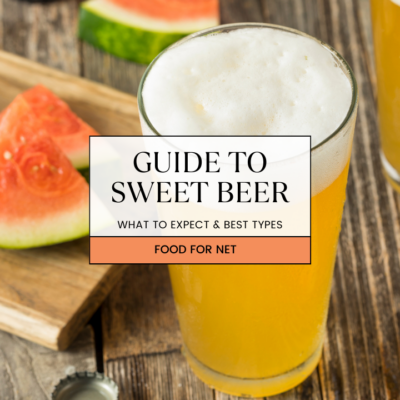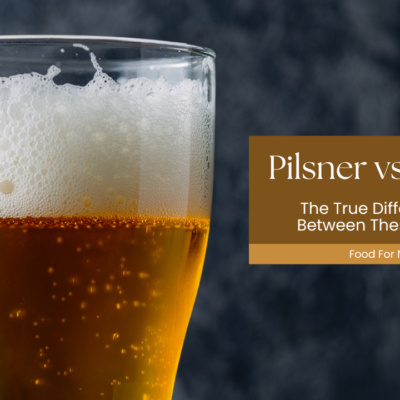
Beer is confusing. There’s really no denying that. Seriously, there are more than 100 different styles of beer and that doesn’t count all the unusual substyles or unique craft beers on the market. The complexity is enough to stop some people from trying beer at all. So, let’s think about one of the main comparisons – lager vs ale.
You might say that all beer (or, at the very least, most beer) is either a lager or an ale. Most people have at least a slight preference for one style over another. Once you have a sense of your preferences, you can start looking at the different substyles and learn the types you enjoy the most.
So, in this post, we’re digging into the differences between lager and ale, including how these beers are created and some of the substyles for each type. There are certainly some broad differences between lager and ale – mostly related to the type of yeast. But, there aren’t as many consistent differences as you might imagine.
What Lager And Ale Have In Common

Obviously, lager and ale are both styles of beer. As such, they’re made from fermented grains and go through a similar creation process.
There are some variations in the precise steps and how they’re conducted depending on the type of beer being produced and who is making it. However, the general approach remains roughly the same regardless and includes the following steps:
- Milling. This involves crushing the grains, which breaks them up and allows the fermentable sugars to be extracted. This creates a product called grist.
- Mash Conversation. The grist is then heated with water to start breaking the starches in the malt down to create sugars.
- Separation and Boiling. The mash is then separated into a sweet liquid called wort and the husks of the grain. The wort can then be boiled, after which point the hops are added.
- Separation and Cooling. There are then separating and cooling steps. The separation helps ensure that no particles of hops or malt remain in the wort.
- Fermentation and Maturation. Once the wort has been cooled and separated, it is fermented and matured to create the finished product.
- Filtration, Carbonation, and Cellaring. The final steps involve filtering the beer, adding carbonation (if desired), and cellaring the beer.
These steps are carried in slightly different ways, using different tools, depending on the scale of production too. For example, the process a home brewer takes will look very different than a large and efficient company, even though the general patterns are the same.
How Lager And Ale Differ

So, if both lager and ale follow the same creation process, what makes the types of beer different from each other?
The Type Of Yeast Used
The biggest difference between lager and ale comes from the yeast used. Ale often relies on Saccharomyces cerevisiae, sometimes called a top fermenting yeast. Lager often uses Saccharomyces pastorianus. This one is typically called a bottom fermenting yeast instead. We’ll talk about those top and bottom distinctions shortly.
The yeasts don’t just behave differently, they’re also quite distinct. Ale yeast is the simpler of the two, as it arises naturally, often on fresh fruit.
Lager yeast is more complex, as it is a hybrid of two different yeast species. This hybridization may have happened back in the Middle Ages and the species remains in common use today. With such differences in origin, it’s no surprise that lager and ale yeasts produce distinct brews.
The difference between these two species is crucial. As you’ll see, this is the only reliable feature that sets ale and lager apart.
Fermentation Temperatures And Locations
The yeast used for lager tends to ferment at lower temperatures, generally around 42°F to 55°F. This makes it a slower and less vigorous process and influences the flavor of the beer. Ale yeast, on the other hand, prefers warmer temperatures (generally between 60°F and 75°F) and tends to ferment toward the top of the vessel instead.
Those are just generalizations though. Yeast tends to move around in the fermentation vessel rather than actually sticking to the top or the bottom.
Similarly, the fermentation temperature will vary depending on the brewer. There’s a large range for each type of yeast anyway, so the temperature difference between lager and ale can be minimal in some cases.
Flavor Profile
Now we come to the flavor. Ales are often more full bodied than lager. They can be sweeter too, although there are some bitter notes from hops. Lagers are typically smoother. They offer some distinct crisp notes, but often have fewer fruity and spicy flavors than ales.
Lagers also tend to be lighter colored than ales and have a lower alcohol content. As such, they can be easier to drink.
At least, that’s the theory. As you’ve probably noticed, there are there are many different styles of ale and of lager. Some of these styles follow the flavor ‘rules’ we just highlighted, while others violate them completely.
What’s Written On The Label
These days, the difference between lager and ale really doesn’t mean that much. Both beer styles can be made in countless ways, including some light easy to drink expressions and others that are full bodied.
Because of this, some people say the difference is simply whether the company calls their beer a lager or an ale. And, honestly, this is a fair point. So, when you’re looking for a new beer, why not step away from the lager versus ale distinction and see which individual styles you prefer instead?
Some Popular Types Of Lager

Some estimates say there are more than 100 different styles and sub-styles of beer, most of which are either a lager or an ale. Listing all those styles here would be almost impossible. However, we will highlight some prevalent and interesting styles.
Pilsner
Pilsner is one of the most well-known types of lager and it’s incredibly popular. This style is defined by the use of hops (often Saaz hops, but not always). These provide distinct complexity and ‘spiciness’ to the beer making it more intense than the typical lager.
A pilsner is basically the beer to choose if you like lagers but find them a little too simple.
However, you’ll need to shop carefully if you want a true pilsner. Many products are referred to as pilsners in some of their marketing, but don’t meet the required standards.
Pilsner-Style Lagers
The technical definition of pilsner often includes a focus on only using malts during fermentation. However, many beers do use non-malt adjuncts.
For example, American-style pilsners often use corn and rice. These adjuncts lighten the color and the body of the pilsner, creating a slightly sweet beer that’s easier to drink. Miller Lite and Corona are both examples of this approach.
Some European-style pilsners use wheat or oats instead. These adjuncts add a creamy or grainy taste to the beer and change the mouthfeel as well.
Such beers are sometimes still called pilsners, while other times they’re known as pilsner-style lagers instead. This is often to distinguish them as less-than-desirable beers such as Budweiser and other “macro” beers.
Light Lager
Light lagers are created with a focus on light colors and flavors. Brewers often use adjuncts like corn or rice to create the desired profile. Many are also low in alcohol content, sometimes getting down to around 2.5% ABV.
The goal is often to create an easy-to-drink beer, making these fantastic beers for warm weather and for anyone who doesn’t drink beer often.
Dark Lager
These beers are indeed dark, yet they are still made using lager yeast rather than ale yeast. The lager yeast means the beers tend to have a more vibrant finish than dark ales, so they’re much easier to drink.
Dark beers are often lower in alcohol than their ale counterparts as well. However, the alcohol content and flavor profile does vary from brewery to brewery. You can expect considerable variation here, as there are many different substyles to these beers.
Some Popular Types Of Ale

Pale Ale
Pale ales are lighter than most other expressions and can even look much like pilsner in a glass. However, pale ales tend to be more complex and have more distinct flavors from hops than most lagers. These ales can have a slightly higher alcohol content as well (depending on the expression).
Indian Pale Ale
Indian pale ale (IPA) is an increasingly popular type of craft beer, partly because the style is so versatile. There’s even a huge range of IPA substyles that all have their own characteristics, like hazy IPAs that have a softer mouthfeel and distinctive flavor, or black IPAs with dark coloring and flavor notes of chocolate and coffee.
There are even beer of the month clubs that focus on IPAs. These allow you to experiment with many different styles of IPAs, including some obscure styles like nitro IPA, quadruple IPA, and white IPA.
American Pale Ale
American pale ale (APA) is another variation on pale ale. It’s similar to American IPA but has some characteristics of its own.
Most of the time, APAs are less hoppy and bitter than American IPAs, with more balance in their flavor profiles. This makes them an easy entry point into the world of IPAs. Of course, that’s a generalization and some APAs may actually be more intense than American IPAs.
Stout
Stout is a dark and fairly intense style of ale, with a dark color and rich flavors from barley. Most of the time, stouts are fairly creamy and have less carbonation than other types of beer. They can also be fairly high in alcohol.
As always, there are plenty of variations, such as oatmeal stout and dry stout. Most are rich and have a complex flavor profile, making them an enjoyable experience for many people.
Porter
Porters are similar to stouts, in that both are dark beers and feature the same coffee and chocolate notes in their flavor profile. However, porters tend to be lighter in color than stouts and may have sweet notes in their flavor profile.
The difference between stouts and porters is the subject of much debate. After all, the styles are fairly similar and many brewers are experimenting with brewing approaches. You may even see the term porter used on beers that others might call a stout and vice versa.
Red Ale
Not surprisingly, red ales do have a distinctive red color, which makes them stand out among other beers. They are often flavorful as well, although they’re not as bitter as IPA or many other ales.
The flavor profile can vary considerably, as red ales fall into a variety of categories. In fact, the name is simply a reference to the color, rather than the flavor of the beer.
Because of this, red ales are a beer style to experiment with. You’ll probably need to try a few different products to determine the styles you enjoy the most.
A Word About Hybrid Beers

There’s a classic claim that all beers are either lagers or ales or lagers. This isn’t necessarily true anymore, as there are also hybrid beers.
These beers have features of both lagers and ales. For example, they may be brewed using lager yeast, but at relatively high ale-like temperatures. Other companies use highly distinct brewing methods that don’t easily fit into either style.
Such beers could all technically be defined as either lagers or ales based on the yeast used and nothing else. However, the term hybrid beer is much more apt.
Should You Drink Ale Or Lager?
There really is no right or wrong approach here. Lagers and ales both have large and passionate fanbases.
Some people find that they just have a couple of beer styles that they really love, while others enjoy many different beers, including some ales and some lagers. It’s really a matter of experimenting to see which beers work well for you.
Beer of the month clubs are an exceptional way to find new beer favorites. Some of these focus on specific types of beer, while others will ship you out a wide variety.
If you’re completely new to beer drinking, it’s often best to start with a lager (perhaps a pilsner). Lagers tend to be light, with subtle flavors and not too much alcohol. This stops them from being too overwhelming.
Pale ales, fruity beers, and sweet beers are also excellent starting points for beginners. These don’t have the strong bitterness or complex flavors found in some other expressions. Over time, you can branch out and experiment with new styles, including ones that are much more bitter.









 Pilsner Vs Lager: Which One Is Right For You?
Pilsner Vs Lager: Which One Is Right For You?
Leave a Reply